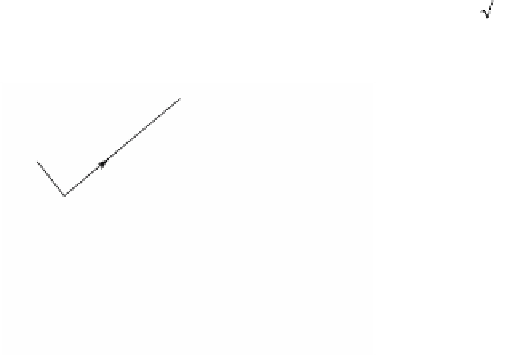Graphics Reference
In-Depth Information
Looking over the solution for Example 2.2.8.4, a reader might wonder if there was
a special reason for choosing the particular orthonormal bases (
u
1
,
u
2
) and (
w
1
,
w
2
).
Not really. The important observation is that no matter what the choice, the three
points
A
,
A
+
u
1
, and
A
+
u
2
will get sent to the points
C
,
C
+
w
1
, and
C
+
w
2
. The line
determined by the points
A
and
A
+
u
1
will get sent to the line determined by
C
and
C
+
w
1
. We could have replaced the bases by (
u
1
, ±
u
2
) and (
w
1
, ±
w
2
) or (-
u
1
, ±
u
2
) and
(-
w
1
, ±
w
2
) and we would have gotten an answer to our problem. On the other hand,
if we want to get a rigid motion then things are not quite so arbitrary. We still have
choices, but the bases must induce the same orientation of the plane. In particular,
we would not be able to pick (
u
1
,
u
2
) and (
w
1
,-
w
2
), for example.
It is easy to see from Example 2.2.8.4 that frames can easily be used to solve the
general problem of mapping one directed line and point to another directed line and
point. The user should compare this approach to how the problem would be solved
without frames. The underlying mathematics is really the same. The orthonormal
bases have the cosines of angles that are used for the rotation contained in them
implicitly. Recall that the components of a unit vector are just direction cosines. Nev-
ertheless, with frames one simply has to build orthonormal bases and this is easier
than messing with angles directly.
Finally, one can also use frames to define motions that send three points to another
three points. For example, suppose that we want to define a motion M that sends
points
A
,
B
, and
C
to points
A
¢,
B
¢, and
C
¢, respectively. See Figure 2.15. Let
F = (
u
1
,
u
2
,
A
) be the frame obtained from the normalized
AB
and the orthogonal
complement of
AC
with respect to
AB
. Let F¢ = (
u
1
¢,
u
2
¢,
A
¢) be the frame obtained in
a similar way from
A
¢,
B
¢, and
C
¢. Then M = F¢F
-1
.
2.2.8.5. Example.
To find the motion M that sends
A
(-2,1),
B
(0,2),
C
(-2,4) to
A
¢(4,0),
B
¢(6,-1),
C
¢(4,-3), respectively.
Solution.
See Figure 2.16. The first task is to define the frames F = (
u
1
,
u
2
,
A
) and
F¢ = (
u
1
¢,
u
2
¢,
A
¢) so that M = F¢F
-1
. To get the orthonormal bases we apply the Gram-
Schmidt algorithm to the bases (
AB
,
AC
) and (
A
¢
B
¢,
A
¢
C
¢). We leave this as an exercise
for the reader. One gets
1
5
1
5
()
(
)
u
=
21
,,
u
=-
12
,
1
2
C
B
u
2
u
1
F¢
A
u
2
¢
F
C¢
A¢
u
1
¢
Figure 2.15.
Using frames to define motions.
B¢











